University Report: Early Childhood Education and Care Wellbeing
VerifiedAdded on 2022/10/18
|11
|2950
|18
Report
AI Summary
This report delves into the critical role of wellbeing in early childhood education and care, emphasizing the significance of nutrition, physical activity, and overall child development. It highlights the importance of parental involvement, focusing on the provision of healthy food, safe environments, and engaging physical activities like animal walks to foster cognitive, emotional, and social growth. The report also addresses government regulations and guidelines for physical activity in different age groups, from infants to teenagers, and underscores the collaborative efforts required between families and childcare centers to ensure a child's healthy and happy life. It further examines the responsibilities of childcare centers, including curriculum development, caregiver roles, and the implementation of playful learning methods to enhance children's learning experiences and overall wellbeing. The report includes a lesson plan example focusing on animal walks to promote physical development and collaborative skills in preschool children, alongside assessment methods to evaluate learning outcomes.
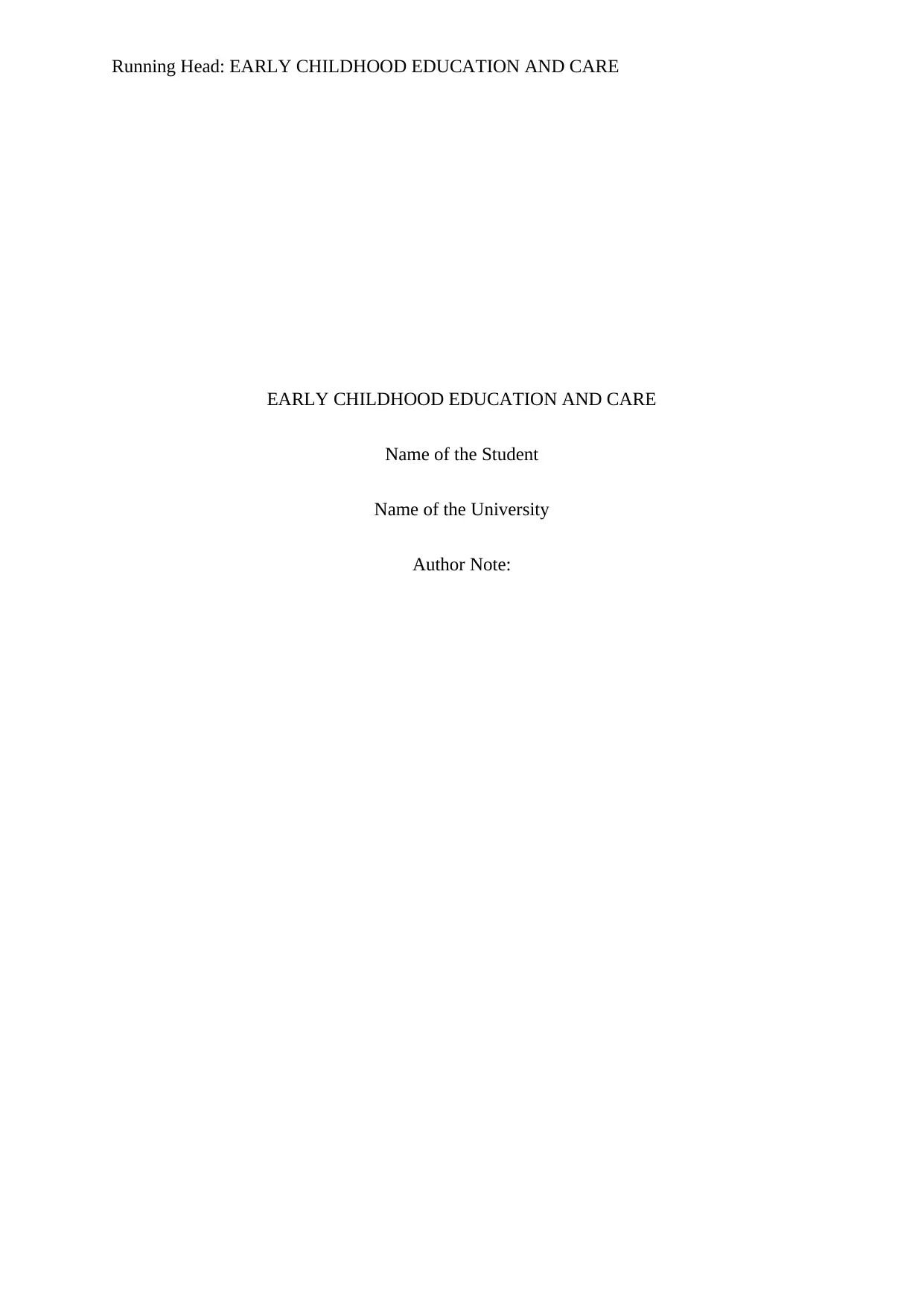
Running Head: EARLY CHILDHOOD EDUCATION AND CARE
EARLY CHILDHOOD EDUCATION AND CARE
Name of the Student
Name of the University
Author Note:
EARLY CHILDHOOD EDUCATION AND CARE
Name of the Student
Name of the University
Author Note:
Paraphrase This Document
Need a fresh take? Get an instant paraphrase of this document with our AI Paraphraser
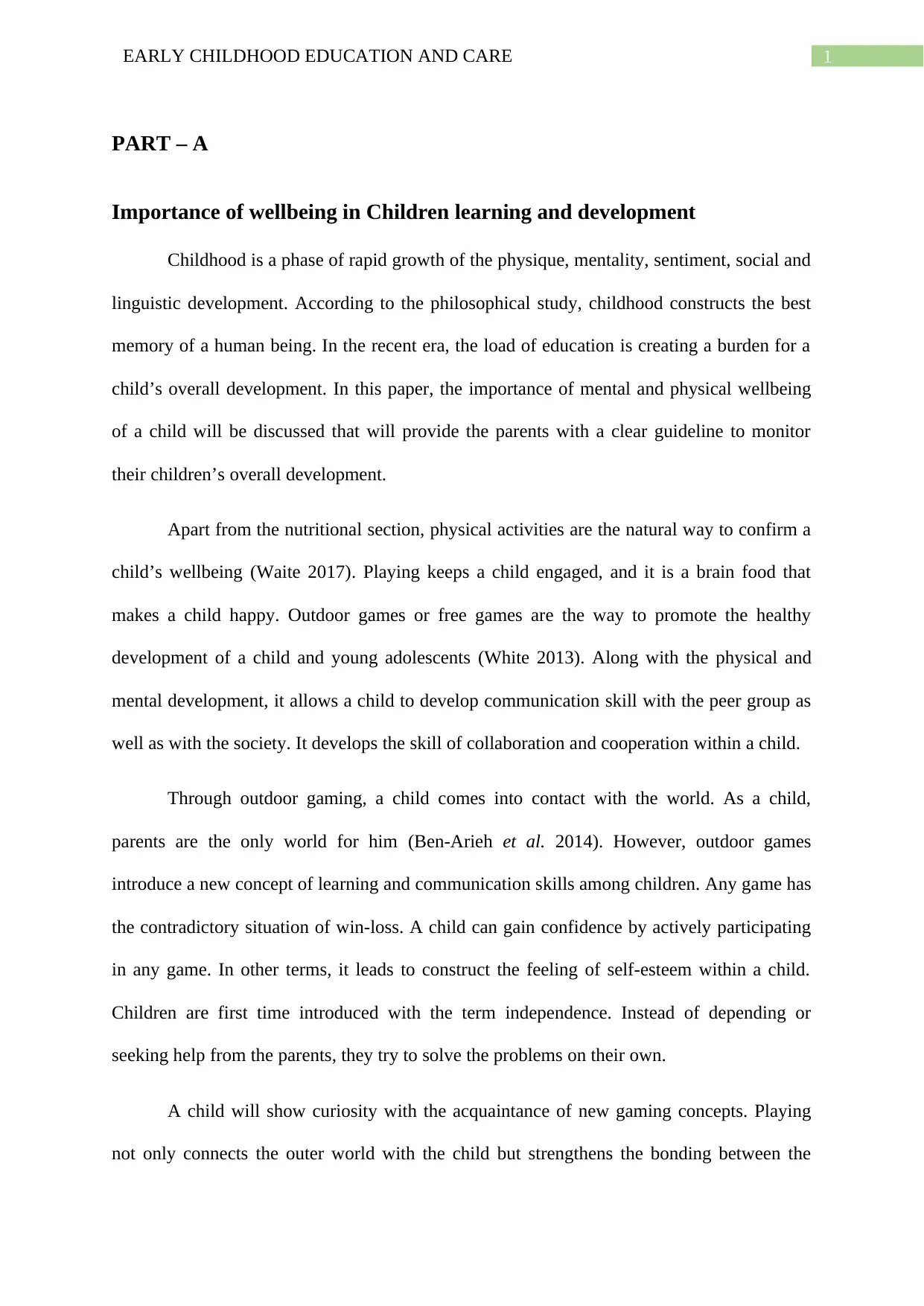
1EARLY CHILDHOOD EDUCATION AND CARE
PART – A
Importance of wellbeing in Children learning and development
Childhood is a phase of rapid growth of the physique, mentality, sentiment, social and
linguistic development. According to the philosophical study, childhood constructs the best
memory of a human being. In the recent era, the load of education is creating a burden for a
child’s overall development. In this paper, the importance of mental and physical wellbeing
of a child will be discussed that will provide the parents with a clear guideline to monitor
their children’s overall development.
Apart from the nutritional section, physical activities are the natural way to confirm a
child’s wellbeing (Waite 2017). Playing keeps a child engaged, and it is a brain food that
makes a child happy. Outdoor games or free games are the way to promote the healthy
development of a child and young adolescents (White 2013). Along with the physical and
mental development, it allows a child to develop communication skill with the peer group as
well as with the society. It develops the skill of collaboration and cooperation within a child.
Through outdoor gaming, a child comes into contact with the world. As a child,
parents are the only world for him (Ben-Arieh et al. 2014). However, outdoor games
introduce a new concept of learning and communication skills among children. Any game has
the contradictory situation of win-loss. A child can gain confidence by actively participating
in any game. In other terms, it leads to construct the feeling of self-esteem within a child.
Children are first time introduced with the term independence. Instead of depending or
seeking help from the parents, they try to solve the problems on their own.
A child will show curiosity with the acquaintance of new gaming concepts. Playing
not only connects the outer world with the child but strengthens the bonding between the
PART – A
Importance of wellbeing in Children learning and development
Childhood is a phase of rapid growth of the physique, mentality, sentiment, social and
linguistic development. According to the philosophical study, childhood constructs the best
memory of a human being. In the recent era, the load of education is creating a burden for a
child’s overall development. In this paper, the importance of mental and physical wellbeing
of a child will be discussed that will provide the parents with a clear guideline to monitor
their children’s overall development.
Apart from the nutritional section, physical activities are the natural way to confirm a
child’s wellbeing (Waite 2017). Playing keeps a child engaged, and it is a brain food that
makes a child happy. Outdoor games or free games are the way to promote the healthy
development of a child and young adolescents (White 2013). Along with the physical and
mental development, it allows a child to develop communication skill with the peer group as
well as with the society. It develops the skill of collaboration and cooperation within a child.
Through outdoor gaming, a child comes into contact with the world. As a child,
parents are the only world for him (Ben-Arieh et al. 2014). However, outdoor games
introduce a new concept of learning and communication skills among children. Any game has
the contradictory situation of win-loss. A child can gain confidence by actively participating
in any game. In other terms, it leads to construct the feeling of self-esteem within a child.
Children are first time introduced with the term independence. Instead of depending or
seeking help from the parents, they try to solve the problems on their own.
A child will show curiosity with the acquaintance of new gaming concepts. Playing
not only connects the outer world with the child but strengthens the bonding between the
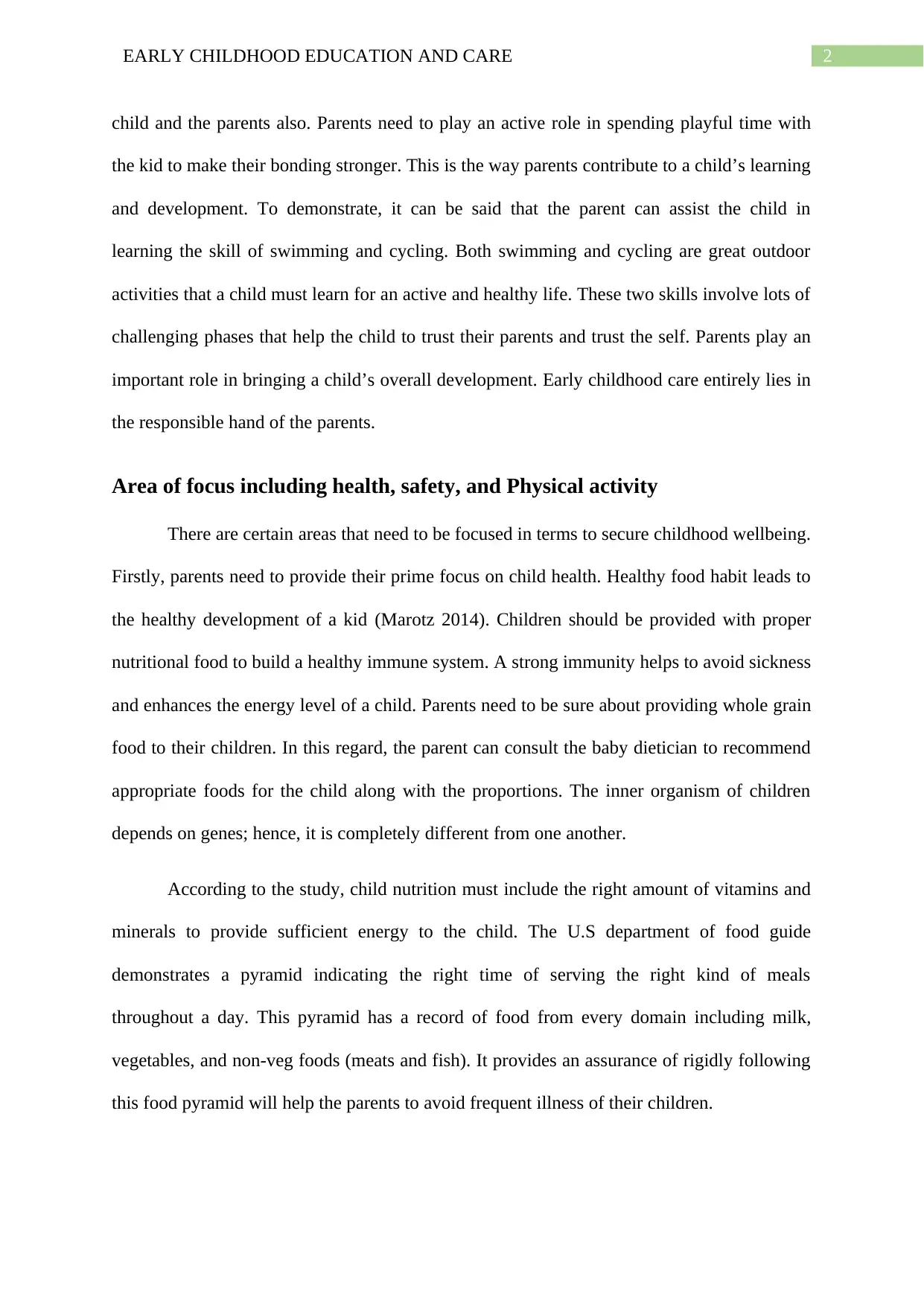
2EARLY CHILDHOOD EDUCATION AND CARE
child and the parents also. Parents need to play an active role in spending playful time with
the kid to make their bonding stronger. This is the way parents contribute to a child’s learning
and development. To demonstrate, it can be said that the parent can assist the child in
learning the skill of swimming and cycling. Both swimming and cycling are great outdoor
activities that a child must learn for an active and healthy life. These two skills involve lots of
challenging phases that help the child to trust their parents and trust the self. Parents play an
important role in bringing a child’s overall development. Early childhood care entirely lies in
the responsible hand of the parents.
Area of focus including health, safety, and Physical activity
There are certain areas that need to be focused in terms to secure childhood wellbeing.
Firstly, parents need to provide their prime focus on child health. Healthy food habit leads to
the healthy development of a kid (Marotz 2014). Children should be provided with proper
nutritional food to build a healthy immune system. A strong immunity helps to avoid sickness
and enhances the energy level of a child. Parents need to be sure about providing whole grain
food to their children. In this regard, the parent can consult the baby dietician to recommend
appropriate foods for the child along with the proportions. The inner organism of children
depends on genes; hence, it is completely different from one another.
According to the study, child nutrition must include the right amount of vitamins and
minerals to provide sufficient energy to the child. The U.S department of food guide
demonstrates a pyramid indicating the right time of serving the right kind of meals
throughout a day. This pyramid has a record of food from every domain including milk,
vegetables, and non-veg foods (meats and fish). It provides an assurance of rigidly following
this food pyramid will help the parents to avoid frequent illness of their children.
child and the parents also. Parents need to play an active role in spending playful time with
the kid to make their bonding stronger. This is the way parents contribute to a child’s learning
and development. To demonstrate, it can be said that the parent can assist the child in
learning the skill of swimming and cycling. Both swimming and cycling are great outdoor
activities that a child must learn for an active and healthy life. These two skills involve lots of
challenging phases that help the child to trust their parents and trust the self. Parents play an
important role in bringing a child’s overall development. Early childhood care entirely lies in
the responsible hand of the parents.
Area of focus including health, safety, and Physical activity
There are certain areas that need to be focused in terms to secure childhood wellbeing.
Firstly, parents need to provide their prime focus on child health. Healthy food habit leads to
the healthy development of a kid (Marotz 2014). Children should be provided with proper
nutritional food to build a healthy immune system. A strong immunity helps to avoid sickness
and enhances the energy level of a child. Parents need to be sure about providing whole grain
food to their children. In this regard, the parent can consult the baby dietician to recommend
appropriate foods for the child along with the proportions. The inner organism of children
depends on genes; hence, it is completely different from one another.
According to the study, child nutrition must include the right amount of vitamins and
minerals to provide sufficient energy to the child. The U.S department of food guide
demonstrates a pyramid indicating the right time of serving the right kind of meals
throughout a day. This pyramid has a record of food from every domain including milk,
vegetables, and non-veg foods (meats and fish). It provides an assurance of rigidly following
this food pyramid will help the parents to avoid frequent illness of their children.
⊘ This is a preview!⊘
Do you want full access?
Subscribe today to unlock all pages.

Trusted by 1+ million students worldwide
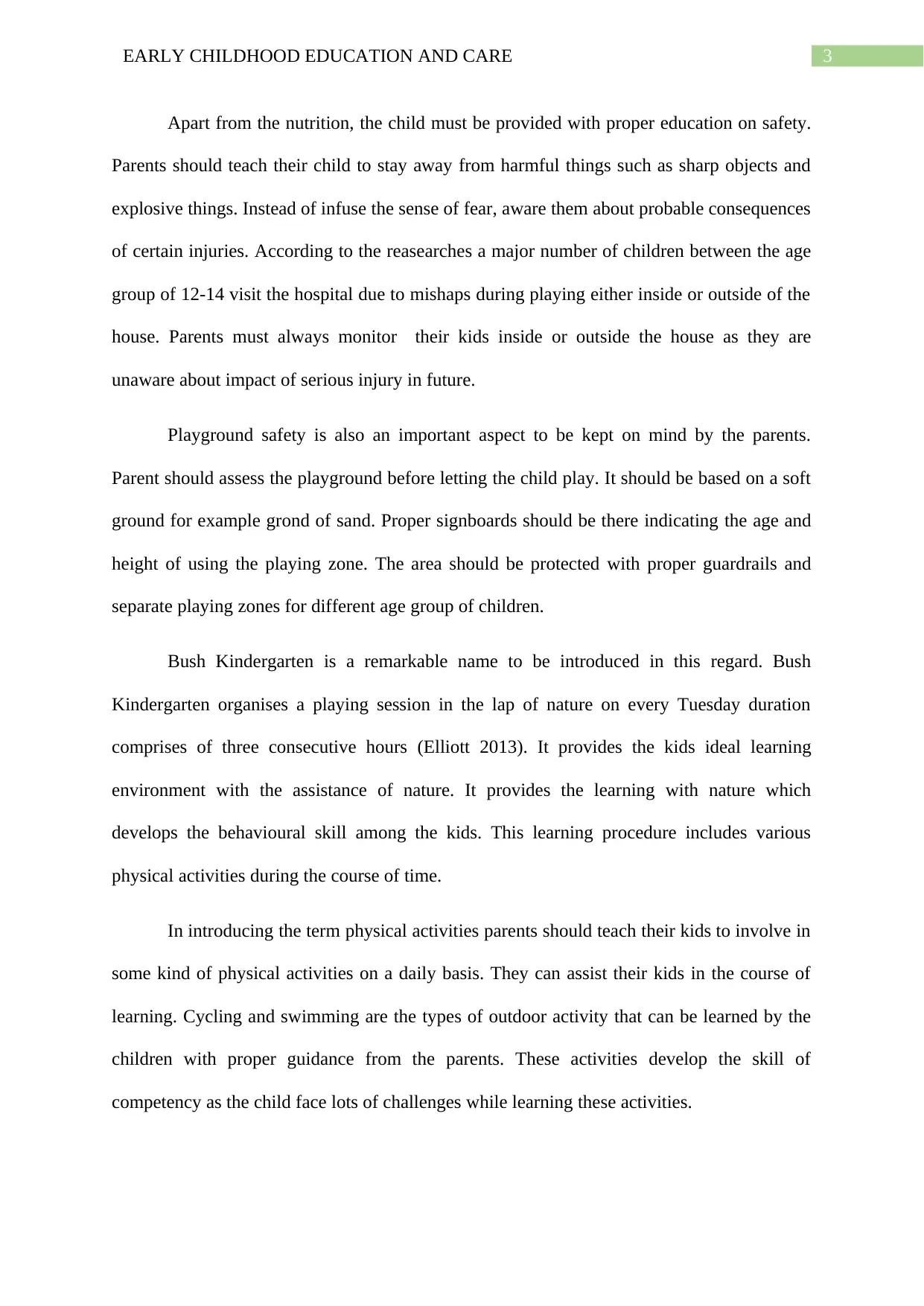
3EARLY CHILDHOOD EDUCATION AND CARE
Apart from the nutrition, the child must be provided with proper education on safety.
Parents should teach their child to stay away from harmful things such as sharp objects and
explosive things. Instead of infuse the sense of fear, aware them about probable consequences
of certain injuries. According to the reasearches a major number of children between the age
group of 12-14 visit the hospital due to mishaps during playing either inside or outside of the
house. Parents must always monitor their kids inside or outside the house as they are
unaware about impact of serious injury in future.
Playground safety is also an important aspect to be kept on mind by the parents.
Parent should assess the playground before letting the child play. It should be based on a soft
ground for example grond of sand. Proper signboards should be there indicating the age and
height of using the playing zone. The area should be protected with proper guardrails and
separate playing zones for different age group of children.
Bush Kindergarten is a remarkable name to be introduced in this regard. Bush
Kindergarten organises a playing session in the lap of nature on every Tuesday duration
comprises of three consecutive hours (Elliott 2013). It provides the kids ideal learning
environment with the assistance of nature. It provides the learning with nature which
develops the behavioural skill among the kids. This learning procedure includes various
physical activities during the course of time.
In introducing the term physical activities parents should teach their kids to involve in
some kind of physical activities on a daily basis. They can assist their kids in the course of
learning. Cycling and swimming are the types of outdoor activity that can be learned by the
children with proper guidance from the parents. These activities develop the skill of
competency as the child face lots of challenges while learning these activities.
Apart from the nutrition, the child must be provided with proper education on safety.
Parents should teach their child to stay away from harmful things such as sharp objects and
explosive things. Instead of infuse the sense of fear, aware them about probable consequences
of certain injuries. According to the reasearches a major number of children between the age
group of 12-14 visit the hospital due to mishaps during playing either inside or outside of the
house. Parents must always monitor their kids inside or outside the house as they are
unaware about impact of serious injury in future.
Playground safety is also an important aspect to be kept on mind by the parents.
Parent should assess the playground before letting the child play. It should be based on a soft
ground for example grond of sand. Proper signboards should be there indicating the age and
height of using the playing zone. The area should be protected with proper guardrails and
separate playing zones for different age group of children.
Bush Kindergarten is a remarkable name to be introduced in this regard. Bush
Kindergarten organises a playing session in the lap of nature on every Tuesday duration
comprises of three consecutive hours (Elliott 2013). It provides the kids ideal learning
environment with the assistance of nature. It provides the learning with nature which
develops the behavioural skill among the kids. This learning procedure includes various
physical activities during the course of time.
In introducing the term physical activities parents should teach their kids to involve in
some kind of physical activities on a daily basis. They can assist their kids in the course of
learning. Cycling and swimming are the types of outdoor activity that can be learned by the
children with proper guidance from the parents. These activities develop the skill of
competency as the child face lots of challenges while learning these activities.
Paraphrase This Document
Need a fresh take? Get an instant paraphrase of this document with our AI Paraphraser
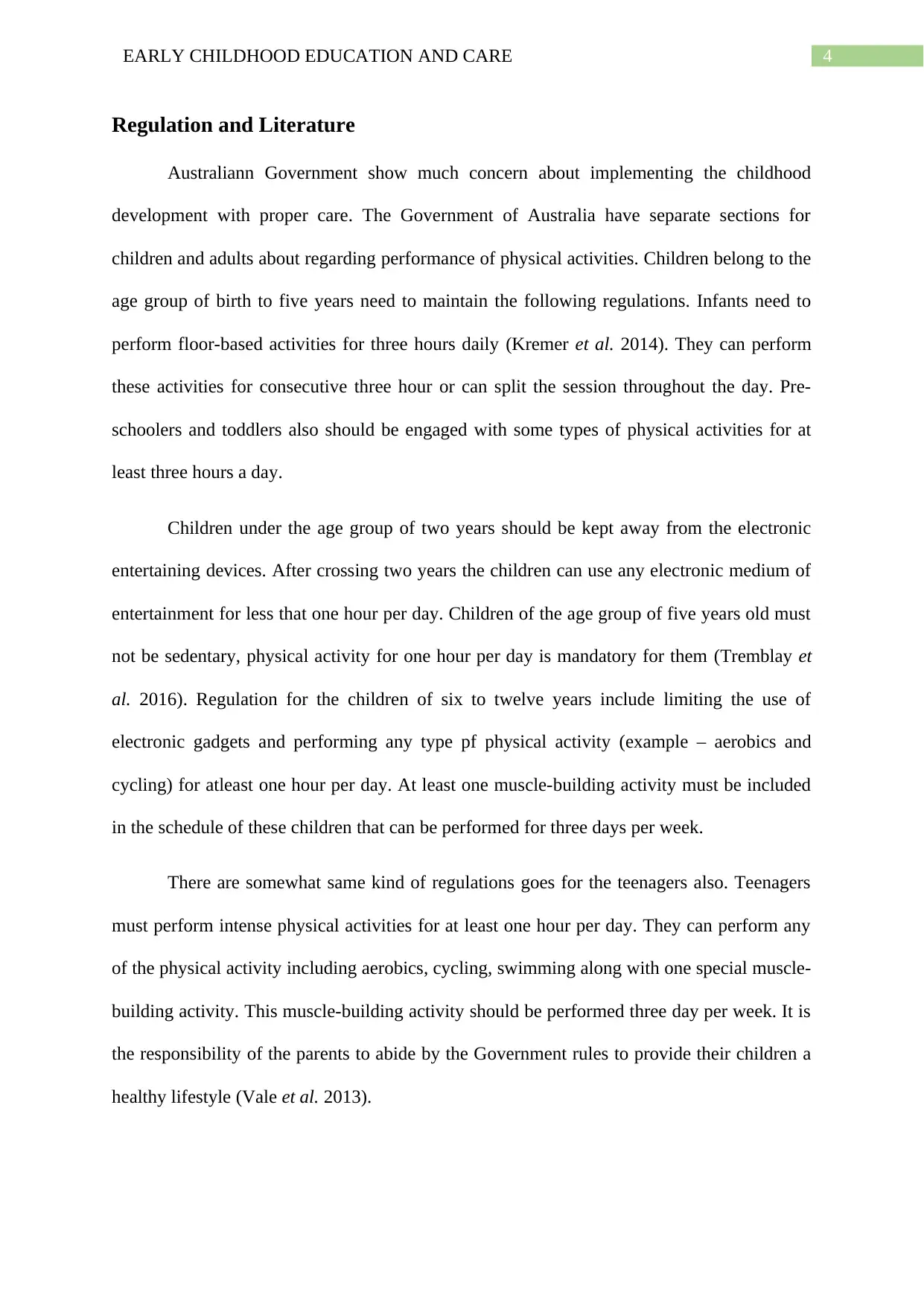
4EARLY CHILDHOOD EDUCATION AND CARE
Regulation and Literature
Australiann Government show much concern about implementing the childhood
development with proper care. The Government of Australia have separate sections for
children and adults about regarding performance of physical activities. Children belong to the
age group of birth to five years need to maintain the following regulations. Infants need to
perform floor-based activities for three hours daily (Kremer et al. 2014). They can perform
these activities for consecutive three hour or can split the session throughout the day. Pre-
schoolers and toddlers also should be engaged with some types of physical activities for at
least three hours a day.
Children under the age group of two years should be kept away from the electronic
entertaining devices. After crossing two years the children can use any electronic medium of
entertainment for less that one hour per day. Children of the age group of five years old must
not be sedentary, physical activity for one hour per day is mandatory for them (Tremblay et
al. 2016). Regulation for the children of six to twelve years include limiting the use of
electronic gadgets and performing any type pf physical activity (example – aerobics and
cycling) for atleast one hour per day. At least one muscle-building activity must be included
in the schedule of these children that can be performed for three days per week.
There are somewhat same kind of regulations goes for the teenagers also. Teenagers
must perform intense physical activities for at least one hour per day. They can perform any
of the physical activity including aerobics, cycling, swimming along with one special muscle-
building activity. This muscle-building activity should be performed three day per week. It is
the responsibility of the parents to abide by the Government rules to provide their children a
healthy lifestyle (Vale et al. 2013).
Regulation and Literature
Australiann Government show much concern about implementing the childhood
development with proper care. The Government of Australia have separate sections for
children and adults about regarding performance of physical activities. Children belong to the
age group of birth to five years need to maintain the following regulations. Infants need to
perform floor-based activities for three hours daily (Kremer et al. 2014). They can perform
these activities for consecutive three hour or can split the session throughout the day. Pre-
schoolers and toddlers also should be engaged with some types of physical activities for at
least three hours a day.
Children under the age group of two years should be kept away from the electronic
entertaining devices. After crossing two years the children can use any electronic medium of
entertainment for less that one hour per day. Children of the age group of five years old must
not be sedentary, physical activity for one hour per day is mandatory for them (Tremblay et
al. 2016). Regulation for the children of six to twelve years include limiting the use of
electronic gadgets and performing any type pf physical activity (example – aerobics and
cycling) for atleast one hour per day. At least one muscle-building activity must be included
in the schedule of these children that can be performed for three days per week.
There are somewhat same kind of regulations goes for the teenagers also. Teenagers
must perform intense physical activities for at least one hour per day. They can perform any
of the physical activity including aerobics, cycling, swimming along with one special muscle-
building activity. This muscle-building activity should be performed three day per week. It is
the responsibility of the parents to abide by the Government rules to provide their children a
healthy lifestyle (Vale et al. 2013).
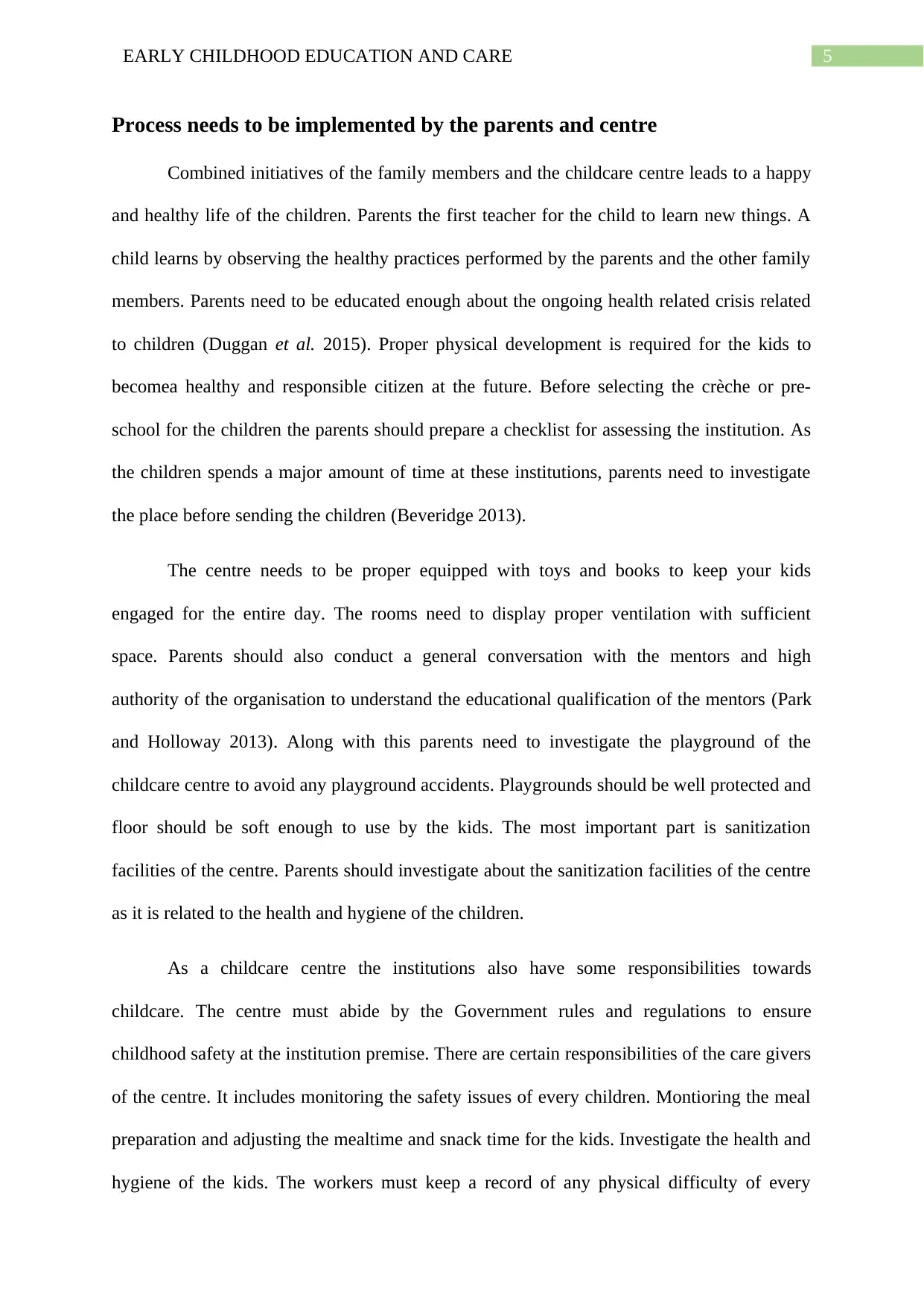
5EARLY CHILDHOOD EDUCATION AND CARE
Process needs to be implemented by the parents and centre
Combined initiatives of the family members and the childcare centre leads to a happy
and healthy life of the children. Parents the first teacher for the child to learn new things. A
child learns by observing the healthy practices performed by the parents and the other family
members. Parents need to be educated enough about the ongoing health related crisis related
to children (Duggan et al. 2015). Proper physical development is required for the kids to
becomea healthy and responsible citizen at the future. Before selecting the crèche or pre-
school for the children the parents should prepare a checklist for assessing the institution. As
the children spends a major amount of time at these institutions, parents need to investigate
the place before sending the children (Beveridge 2013).
The centre needs to be proper equipped with toys and books to keep your kids
engaged for the entire day. The rooms need to display proper ventilation with sufficient
space. Parents should also conduct a general conversation with the mentors and high
authority of the organisation to understand the educational qualification of the mentors (Park
and Holloway 2013). Along with this parents need to investigate the playground of the
childcare centre to avoid any playground accidents. Playgrounds should be well protected and
floor should be soft enough to use by the kids. The most important part is sanitization
facilities of the centre. Parents should investigate about the sanitization facilities of the centre
as it is related to the health and hygiene of the children.
As a childcare centre the institutions also have some responsibilities towards
childcare. The centre must abide by the Government rules and regulations to ensure
childhood safety at the institution premise. There are certain responsibilities of the care givers
of the centre. It includes monitoring the safety issues of every children. Montioring the meal
preparation and adjusting the mealtime and snack time for the kids. Investigate the health and
hygiene of the kids. The workers must keep a record of any physical difficulty of every
Process needs to be implemented by the parents and centre
Combined initiatives of the family members and the childcare centre leads to a happy
and healthy life of the children. Parents the first teacher for the child to learn new things. A
child learns by observing the healthy practices performed by the parents and the other family
members. Parents need to be educated enough about the ongoing health related crisis related
to children (Duggan et al. 2015). Proper physical development is required for the kids to
becomea healthy and responsible citizen at the future. Before selecting the crèche or pre-
school for the children the parents should prepare a checklist for assessing the institution. As
the children spends a major amount of time at these institutions, parents need to investigate
the place before sending the children (Beveridge 2013).
The centre needs to be proper equipped with toys and books to keep your kids
engaged for the entire day. The rooms need to display proper ventilation with sufficient
space. Parents should also conduct a general conversation with the mentors and high
authority of the organisation to understand the educational qualification of the mentors (Park
and Holloway 2013). Along with this parents need to investigate the playground of the
childcare centre to avoid any playground accidents. Playgrounds should be well protected and
floor should be soft enough to use by the kids. The most important part is sanitization
facilities of the centre. Parents should investigate about the sanitization facilities of the centre
as it is related to the health and hygiene of the children.
As a childcare centre the institutions also have some responsibilities towards
childcare. The centre must abide by the Government rules and regulations to ensure
childhood safety at the institution premise. There are certain responsibilities of the care givers
of the centre. It includes monitoring the safety issues of every children. Montioring the meal
preparation and adjusting the mealtime and snack time for the kids. Investigate the health and
hygiene of the kids. The workers must keep a record of any physical difficulty of every
⊘ This is a preview!⊘
Do you want full access?
Subscribe today to unlock all pages.

Trusted by 1+ million students worldwide
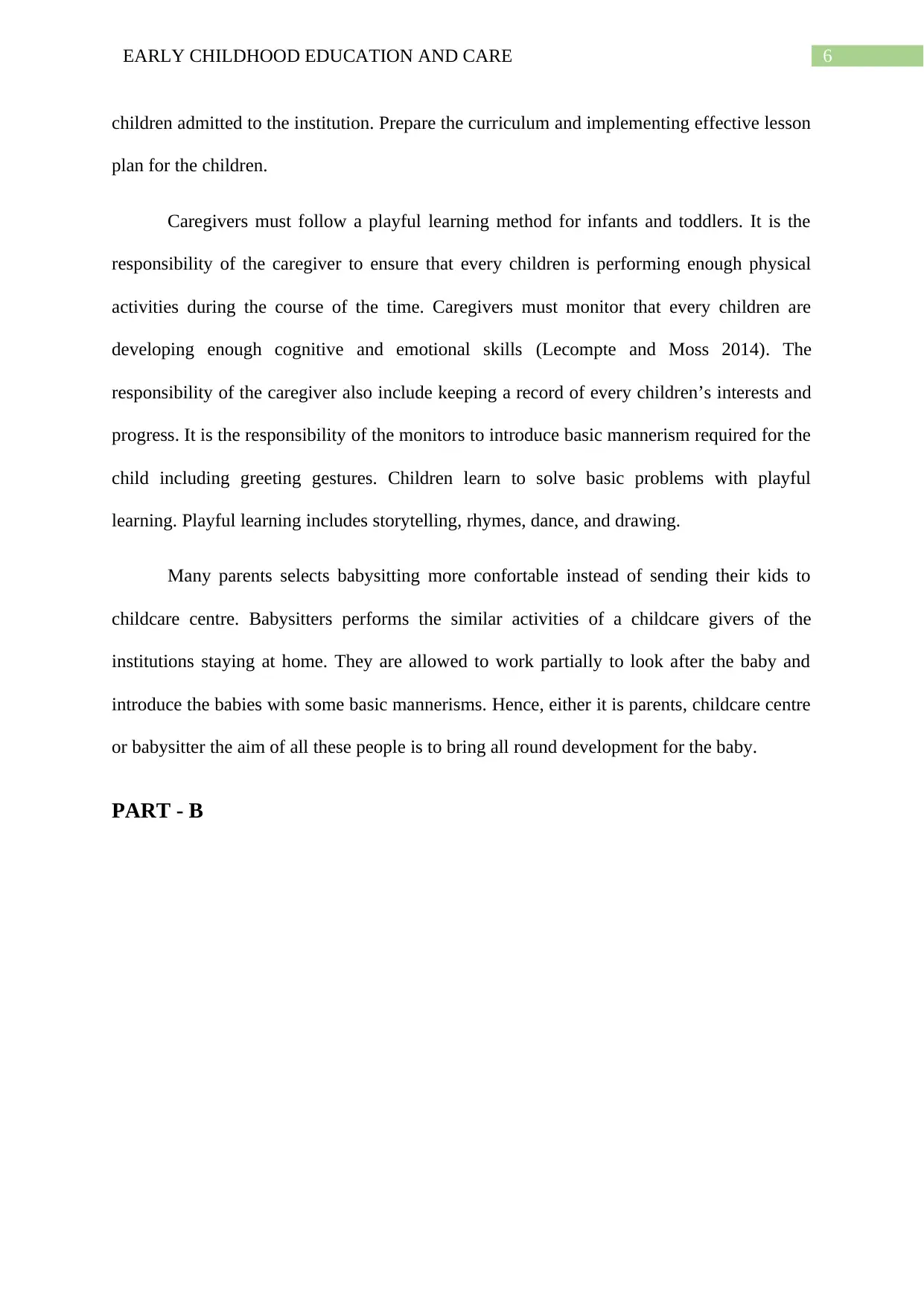
6EARLY CHILDHOOD EDUCATION AND CARE
children admitted to the institution. Prepare the curriculum and implementing effective lesson
plan for the children.
Caregivers must follow a playful learning method for infants and toddlers. It is the
responsibility of the caregiver to ensure that every children is performing enough physical
activities during the course of the time. Caregivers must monitor that every children are
developing enough cognitive and emotional skills (Lecompte and Moss 2014). The
responsibility of the caregiver also include keeping a record of every children’s interests and
progress. It is the responsibility of the monitors to introduce basic mannerism required for the
child including greeting gestures. Children learn to solve basic problems with playful
learning. Playful learning includes storytelling, rhymes, dance, and drawing.
Many parents selects babysitting more confortable instead of sending their kids to
childcare centre. Babysitters performs the similar activities of a childcare givers of the
institutions staying at home. They are allowed to work partially to look after the baby and
introduce the babies with some basic mannerisms. Hence, either it is parents, childcare centre
or babysitter the aim of all these people is to bring all round development for the baby.
PART - B
children admitted to the institution. Prepare the curriculum and implementing effective lesson
plan for the children.
Caregivers must follow a playful learning method for infants and toddlers. It is the
responsibility of the caregiver to ensure that every children is performing enough physical
activities during the course of the time. Caregivers must monitor that every children are
developing enough cognitive and emotional skills (Lecompte and Moss 2014). The
responsibility of the caregiver also include keeping a record of every children’s interests and
progress. It is the responsibility of the monitors to introduce basic mannerism required for the
child including greeting gestures. Children learn to solve basic problems with playful
learning. Playful learning includes storytelling, rhymes, dance, and drawing.
Many parents selects babysitting more confortable instead of sending their kids to
childcare centre. Babysitters performs the similar activities of a childcare givers of the
institutions staying at home. They are allowed to work partially to look after the baby and
introduce the babies with some basic mannerisms. Hence, either it is parents, childcare centre
or babysitter the aim of all these people is to bring all round development for the baby.
PART - B
Paraphrase This Document
Need a fresh take? Get an instant paraphrase of this document with our AI Paraphraser
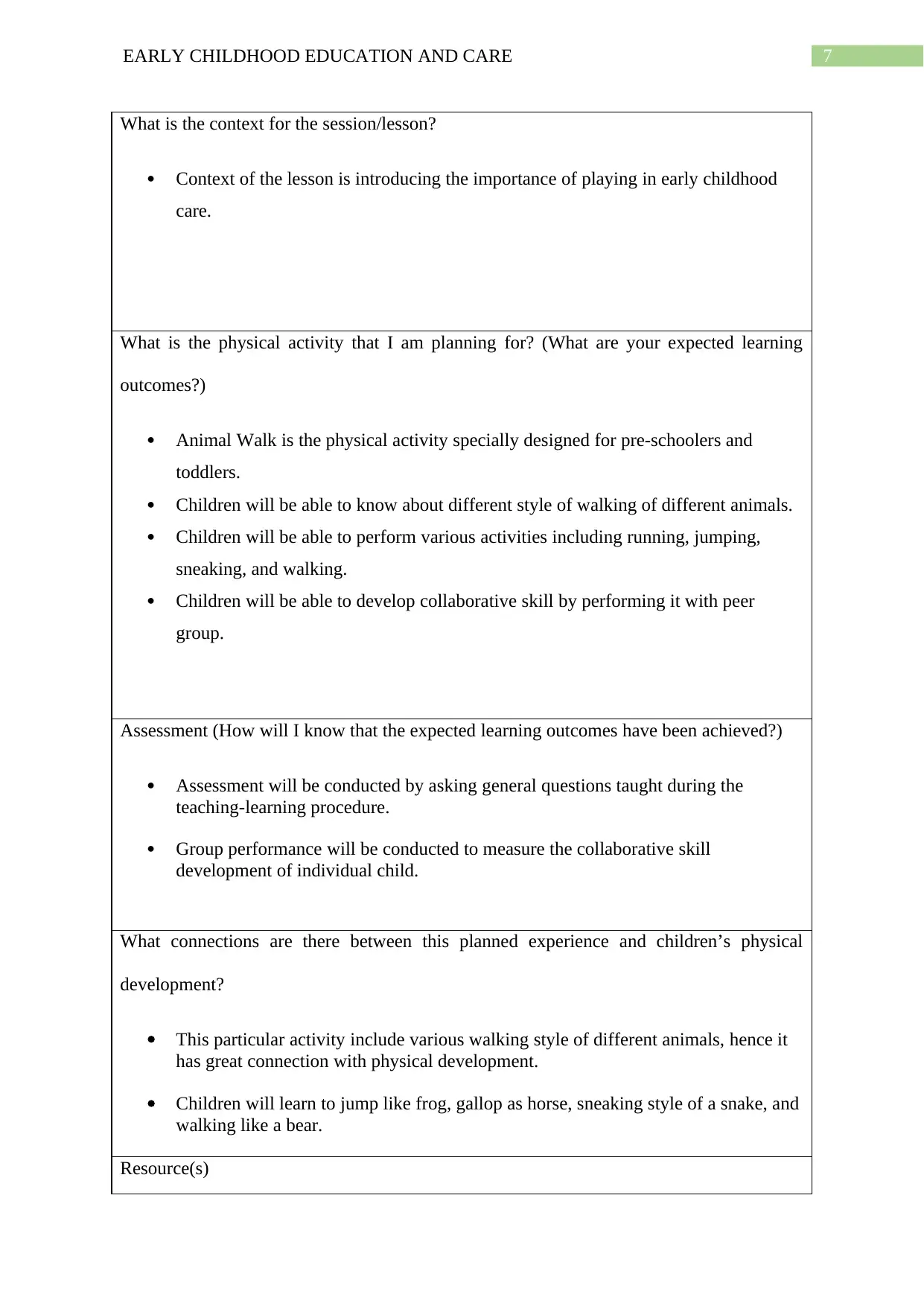
7EARLY CHILDHOOD EDUCATION AND CARE
What is the context for the session/lesson?
Context of the lesson is introducing the importance of playing in early childhood
care.
What is the physical activity that I am planning for? (What are your expected learning
outcomes?)
Animal Walk is the physical activity specially designed for pre-schoolers and
toddlers.
Children will be able to know about different style of walking of different animals.
Children will be able to perform various activities including running, jumping,
sneaking, and walking.
Children will be able to develop collaborative skill by performing it with peer
group.
Assessment (How will I know that the expected learning outcomes have been achieved?)
Assessment will be conducted by asking general questions taught during the
teaching-learning procedure.
Group performance will be conducted to measure the collaborative skill
development of individual child.
What connections are there between this planned experience and children’s physical
development?
This particular activity include various walking style of different animals, hence it
has great connection with physical development.
Children will learn to jump like frog, gallop as horse, sneaking style of a snake, and
walking like a bear.
Resource(s)
What is the context for the session/lesson?
Context of the lesson is introducing the importance of playing in early childhood
care.
What is the physical activity that I am planning for? (What are your expected learning
outcomes?)
Animal Walk is the physical activity specially designed for pre-schoolers and
toddlers.
Children will be able to know about different style of walking of different animals.
Children will be able to perform various activities including running, jumping,
sneaking, and walking.
Children will be able to develop collaborative skill by performing it with peer
group.
Assessment (How will I know that the expected learning outcomes have been achieved?)
Assessment will be conducted by asking general questions taught during the
teaching-learning procedure.
Group performance will be conducted to measure the collaborative skill
development of individual child.
What connections are there between this planned experience and children’s physical
development?
This particular activity include various walking style of different animals, hence it
has great connection with physical development.
Children will learn to jump like frog, gallop as horse, sneaking style of a snake, and
walking like a bear.
Resource(s)
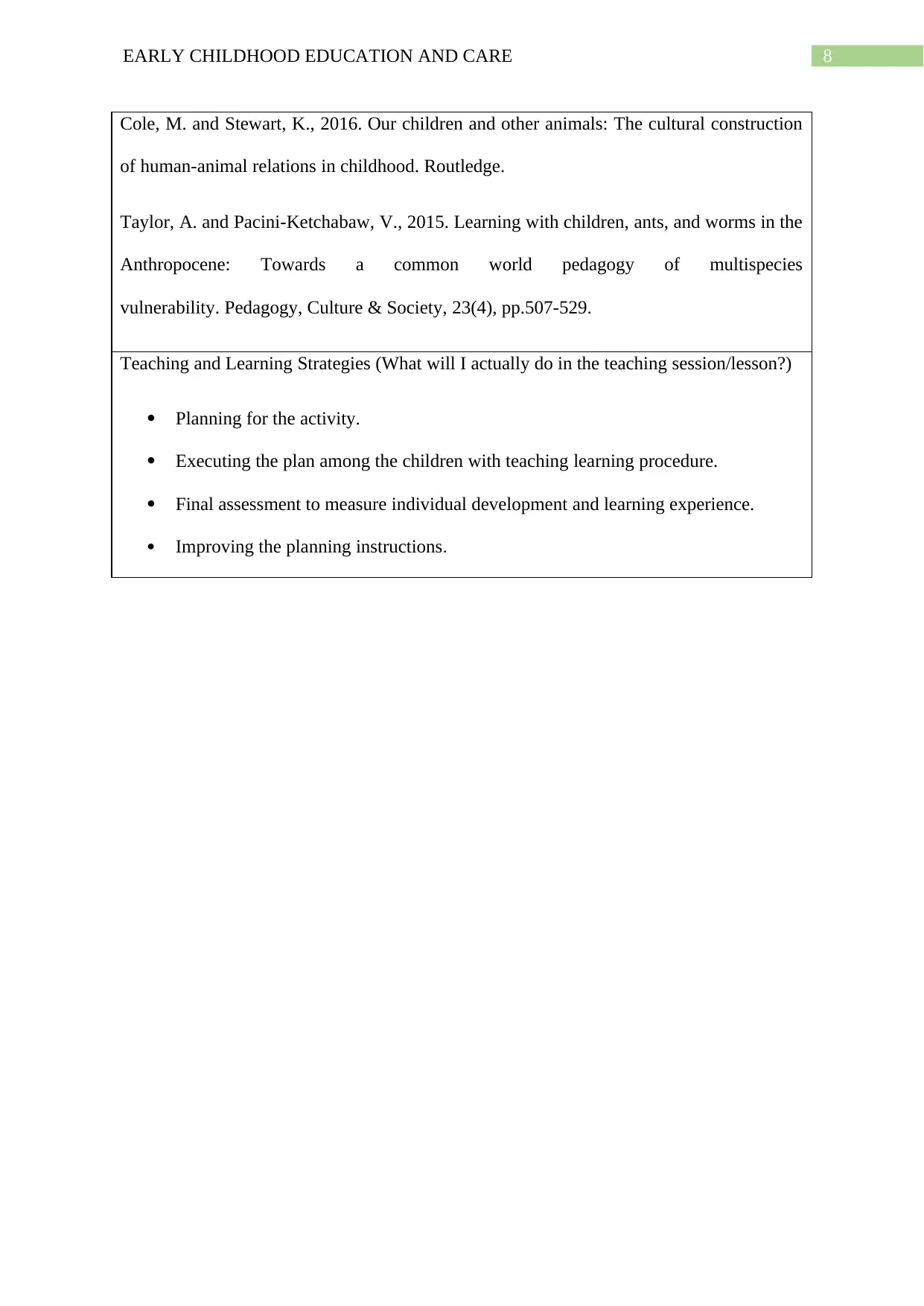
8EARLY CHILDHOOD EDUCATION AND CARE
Cole, M. and Stewart, K., 2016. Our children and other animals: The cultural construction
of human-animal relations in childhood. Routledge.
Taylor, A. and Pacini-Ketchabaw, V., 2015. Learning with children, ants, and worms in the
Anthropocene: Towards a common world pedagogy of multispecies
vulnerability. Pedagogy, Culture & Society, 23(4), pp.507-529.
Teaching and Learning Strategies (What will I actually do in the teaching session/lesson?)
Planning for the activity.
Executing the plan among the children with teaching learning procedure.
Final assessment to measure individual development and learning experience.
Improving the planning instructions.
Cole, M. and Stewart, K., 2016. Our children and other animals: The cultural construction
of human-animal relations in childhood. Routledge.
Taylor, A. and Pacini-Ketchabaw, V., 2015. Learning with children, ants, and worms in the
Anthropocene: Towards a common world pedagogy of multispecies
vulnerability. Pedagogy, Culture & Society, 23(4), pp.507-529.
Teaching and Learning Strategies (What will I actually do in the teaching session/lesson?)
Planning for the activity.
Executing the plan among the children with teaching learning procedure.
Final assessment to measure individual development and learning experience.
Improving the planning instructions.
⊘ This is a preview!⊘
Do you want full access?
Subscribe today to unlock all pages.

Trusted by 1+ million students worldwide
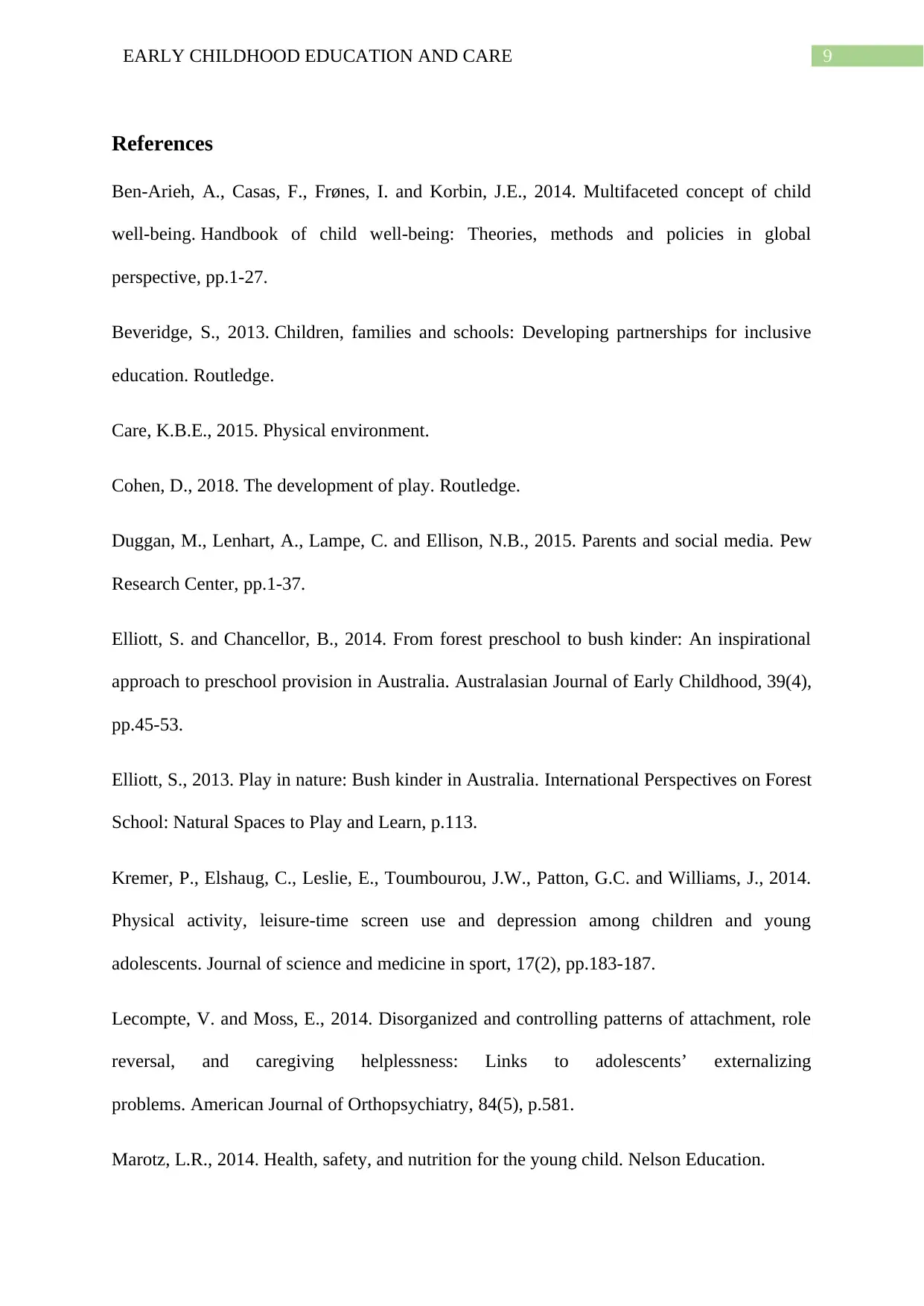
9EARLY CHILDHOOD EDUCATION AND CARE
References
Ben-Arieh, A., Casas, F., Frønes, I. and Korbin, J.E., 2014. Multifaceted concept of child
well-being. Handbook of child well-being: Theories, methods and policies in global
perspective, pp.1-27.
Beveridge, S., 2013. Children, families and schools: Developing partnerships for inclusive
education. Routledge.
Care, K.B.E., 2015. Physical environment.
Cohen, D., 2018. The development of play. Routledge.
Duggan, M., Lenhart, A., Lampe, C. and Ellison, N.B., 2015. Parents and social media. Pew
Research Center, pp.1-37.
Elliott, S. and Chancellor, B., 2014. From forest preschool to bush kinder: An inspirational
approach to preschool provision in Australia. Australasian Journal of Early Childhood, 39(4),
pp.45-53.
Elliott, S., 2013. Play in nature: Bush kinder in Australia. International Perspectives on Forest
School: Natural Spaces to Play and Learn, p.113.
Kremer, P., Elshaug, C., Leslie, E., Toumbourou, J.W., Patton, G.C. and Williams, J., 2014.
Physical activity, leisure-time screen use and depression among children and young
adolescents. Journal of science and medicine in sport, 17(2), pp.183-187.
Lecompte, V. and Moss, E., 2014. Disorganized and controlling patterns of attachment, role
reversal, and caregiving helplessness: Links to adolescents’ externalizing
problems. American Journal of Orthopsychiatry, 84(5), p.581.
Marotz, L.R., 2014. Health, safety, and nutrition for the young child. Nelson Education.
References
Ben-Arieh, A., Casas, F., Frønes, I. and Korbin, J.E., 2014. Multifaceted concept of child
well-being. Handbook of child well-being: Theories, methods and policies in global
perspective, pp.1-27.
Beveridge, S., 2013. Children, families and schools: Developing partnerships for inclusive
education. Routledge.
Care, K.B.E., 2015. Physical environment.
Cohen, D., 2018. The development of play. Routledge.
Duggan, M., Lenhart, A., Lampe, C. and Ellison, N.B., 2015. Parents and social media. Pew
Research Center, pp.1-37.
Elliott, S. and Chancellor, B., 2014. From forest preschool to bush kinder: An inspirational
approach to preschool provision in Australia. Australasian Journal of Early Childhood, 39(4),
pp.45-53.
Elliott, S., 2013. Play in nature: Bush kinder in Australia. International Perspectives on Forest
School: Natural Spaces to Play and Learn, p.113.
Kremer, P., Elshaug, C., Leslie, E., Toumbourou, J.W., Patton, G.C. and Williams, J., 2014.
Physical activity, leisure-time screen use and depression among children and young
adolescents. Journal of science and medicine in sport, 17(2), pp.183-187.
Lecompte, V. and Moss, E., 2014. Disorganized and controlling patterns of attachment, role
reversal, and caregiving helplessness: Links to adolescents’ externalizing
problems. American Journal of Orthopsychiatry, 84(5), p.581.
Marotz, L.R., 2014. Health, safety, and nutrition for the young child. Nelson Education.
Paraphrase This Document
Need a fresh take? Get an instant paraphrase of this document with our AI Paraphraser
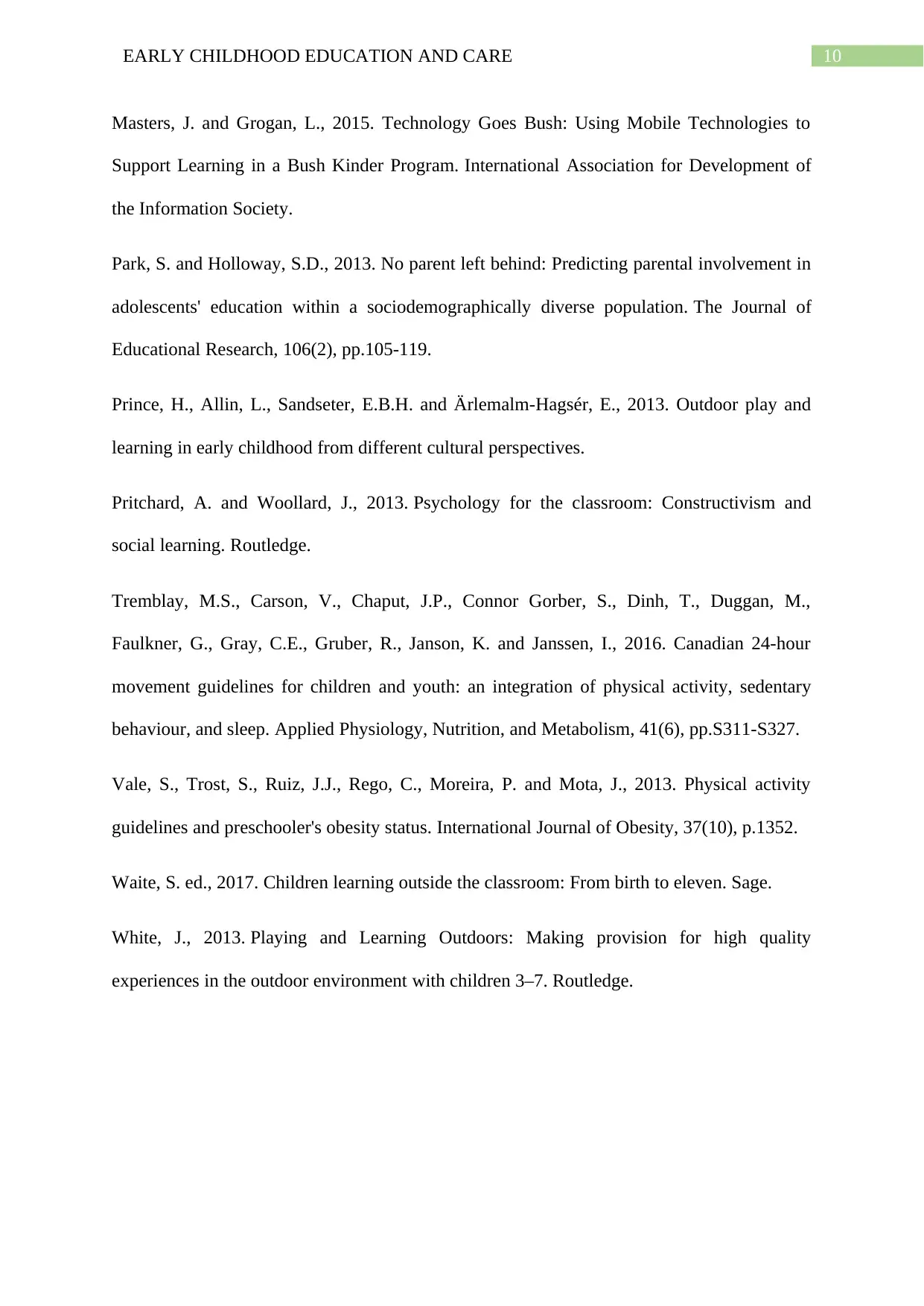
10EARLY CHILDHOOD EDUCATION AND CARE
Masters, J. and Grogan, L., 2015. Technology Goes Bush: Using Mobile Technologies to
Support Learning in a Bush Kinder Program. International Association for Development of
the Information Society.
Park, S. and Holloway, S.D., 2013. No parent left behind: Predicting parental involvement in
adolescents' education within a sociodemographically diverse population. The Journal of
Educational Research, 106(2), pp.105-119.
Prince, H., Allin, L., Sandseter, E.B.H. and Ärlemalm-Hagsér, E., 2013. Outdoor play and
learning in early childhood from different cultural perspectives.
Pritchard, A. and Woollard, J., 2013. Psychology for the classroom: Constructivism and
social learning. Routledge.
Tremblay, M.S., Carson, V., Chaput, J.P., Connor Gorber, S., Dinh, T., Duggan, M.,
Faulkner, G., Gray, C.E., Gruber, R., Janson, K. and Janssen, I., 2016. Canadian 24-hour
movement guidelines for children and youth: an integration of physical activity, sedentary
behaviour, and sleep. Applied Physiology, Nutrition, and Metabolism, 41(6), pp.S311-S327.
Vale, S., Trost, S., Ruiz, J.J., Rego, C., Moreira, P. and Mota, J., 2013. Physical activity
guidelines and preschooler's obesity status. International Journal of Obesity, 37(10), p.1352.
Waite, S. ed., 2017. Children learning outside the classroom: From birth to eleven. Sage.
White, J., 2013. Playing and Learning Outdoors: Making provision for high quality
experiences in the outdoor environment with children 3–7. Routledge.
Masters, J. and Grogan, L., 2015. Technology Goes Bush: Using Mobile Technologies to
Support Learning in a Bush Kinder Program. International Association for Development of
the Information Society.
Park, S. and Holloway, S.D., 2013. No parent left behind: Predicting parental involvement in
adolescents' education within a sociodemographically diverse population. The Journal of
Educational Research, 106(2), pp.105-119.
Prince, H., Allin, L., Sandseter, E.B.H. and Ärlemalm-Hagsér, E., 2013. Outdoor play and
learning in early childhood from different cultural perspectives.
Pritchard, A. and Woollard, J., 2013. Psychology for the classroom: Constructivism and
social learning. Routledge.
Tremblay, M.S., Carson, V., Chaput, J.P., Connor Gorber, S., Dinh, T., Duggan, M.,
Faulkner, G., Gray, C.E., Gruber, R., Janson, K. and Janssen, I., 2016. Canadian 24-hour
movement guidelines for children and youth: an integration of physical activity, sedentary
behaviour, and sleep. Applied Physiology, Nutrition, and Metabolism, 41(6), pp.S311-S327.
Vale, S., Trost, S., Ruiz, J.J., Rego, C., Moreira, P. and Mota, J., 2013. Physical activity
guidelines and preschooler's obesity status. International Journal of Obesity, 37(10), p.1352.
Waite, S. ed., 2017. Children learning outside the classroom: From birth to eleven. Sage.
White, J., 2013. Playing and Learning Outdoors: Making provision for high quality
experiences in the outdoor environment with children 3–7. Routledge.
1 out of 11
Related Documents
Your All-in-One AI-Powered Toolkit for Academic Success.
+13062052269
info@desklib.com
Available 24*7 on WhatsApp / Email
![[object Object]](/_next/static/media/star-bottom.7253800d.svg)
Unlock your academic potential
Copyright © 2020–2025 A2Z Services. All Rights Reserved. Developed and managed by ZUCOL.



